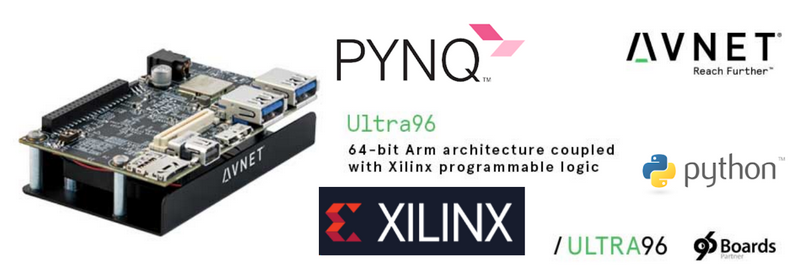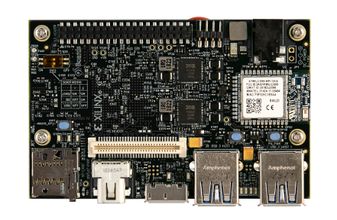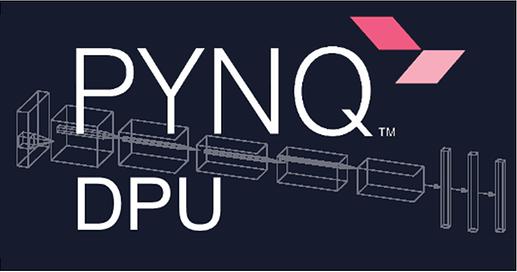Click the releases tab above or click here to obtain SD card images and instructions for Ultra96 v1 or v2
Supports Ultra96 v1 and v2, ZCU104 and ZCU111, click here for how to get started!
This repository contains source files and instructions for building PYNQ to run on the Ultra96 board.
Users can leverage the included Petalinux BSPs to build the images on their own.
Building PYNQ for Ultra96 can take many hours to complete. Plan accordingly!
Required tools:
- Ubuntu 16.04 LTS 64-bit host PC
- Passwordless SUDO privilege for the building user
- At least 160GB of free hard disk space if you do not have the Xilinx tools installed yet
- Roughly 80GB of free hard drive space if you have the Xilinx tools installed
- You may be able to work with less free hard drive space, YMMV
- At least 8GB of RAM (more is better)
- Xilinx PetaLinux and Vivado or SDx (find the version compatible with a specific PYNQ release at Xilinx Tool Version)
- Read Xilinx UG1144 for PetaLinux host PC setup requirements
- Create a Xilinx account to obtain and license the tools
Retrieve the Ultra96 PYNQ board git into a NEW directory somewhere outside the PYNQ git directory.
git clone https://github.com/Avnet/Ultra96-PYNQ.git <LOCAL ULTRA96>Setup Ultra96-PYNQ git to work on a branch (for example,image_v2.5).
cd <LOCAL ULTRA96>
git checkout origin/image_v2.5BSPs for building PYNQ for Ultra96 V1 and V2 are already included in this repo. Users can use these BSPs to build PYNQ images by themselves. If you would like to build your own BSPs, see notes at bottom.
Change the softlinks to point to the desired board version spec file by replacing 'X' with '1' or '2'.
cd <LOCAL ULTRA96>/Ultra96
ln -s specs/Ultra96_vX.spec Ultra96.spec
ln -s petalinux_bsp_vX petalinux_bsp
cp -f sensors96b/sensors96b.bit.vX sensors96b/sensors96b.bit
cp -f sensors96b/sensors96b.tcl.vX sensors96b/sensors96b.tcl
cp -f sensors96b/sensors96b.hwh.vX sensors96b/sensors96b.hwhRetrieve the main PYNQ repo into a NEW directory somewhere outside the Ultra96-PYNQ directory.
git clone https://github.com/Xilinx/PYNQ.git <LOCAL PYNQ>Setup PYNQ git to work on a branch (for example, image_v2.5).
cd <LOCAL PYNQ>
git checkout origin/image_v2.5Configure and install build tools, this will take some effort and will be an iterative process. Run setup_host.sh to install missing tools, make checkenv to check if all tools are installed.
cd sdbuild
./scripts/setup_host.sh
make checkenvIn your PYNQ repository go to the directory sdbuild and run make.
IMPORTANT: For the BOARDDIR path setting it should be absolute not relative, you have been warned!
make clean
make BOARDDIR=<LOCAL ULTRA96>Once the build has completed (it will take a long long time), if successful an SD card image will be available under the PYNQ git directory sdbuild/output. Depending on the PYNQ release, the image may have different names. As an example, for PYNQ v2.5, the image is Ultra96-2.5.img.
Use Etcher or Win32DiskImager to write this image to an SD card.
Insert card, PYNQ should boot up on the Ultra96!
For more information about how to setup and use PYNQ for Ultra96, please refer to the online documentation.
If making your own bsp and building it outside of Ultra96 PYNQ you must include the missing file, bsp.cfg and recipe found here: u-boot fixes
If building your bsp within the Ultra96 PYNQ build system, the u-boot fixes will be automatically applied
Note: building your own bsp is optional. It is only needed if you have a good reason not to use the included BSP.
Obtain and install Xilinx Vivado or SDx and PetaLinux on Ubuntu 16.04 LTS. For Xilinx tools, you will need a version compatible with the PYNQ release (for Xilinx tool compatibility, see Xilinx Tool Version). If you are installing the Xilinx tools for the first time on your existing setup you must read Xilinx UG1144 for PetaLinux setup requirements.
If you prefer, you can also setup all the tools on a VirtualBox VM (e.g. using Vagrant software).
If you purchased an Ultra96 board, a free voucher for the full-version Xilinx SDX tool suite and PetaLinux is included.
Use the Xilinx SDx or Vivado tools to generate the hardware design. The hardware design source files contain a PL (Xilinx Programmable Logic) design that will enable PYNQ to interact with a Grove mezzanine board. The hardware design also contains Ultra96 board specific settings. After building the hardware design, it will need to be manually imported into the PetaLinux BSP:
cd <LOCAL ULTRA96>/Ultra96/sensors96b
cp -f sensors96b.tcl.vX sensors96b.tcl
makeAfter the hardware design has finished building and you have installed PetaLinux then create the Ultra96 BSP by executing PetaLinux commands from the ROOT DIRECTORY of the Ultra96 PYNQ board git. You may see a couple warnings after the petalinux-config, those are normal:
cd <LOCAL ULTRA96>
mkdir bsp
cd bsp
petalinux-create -t project -n sensors96b --template zynqMP
cd sensors96b
petalinux-config --get-hw-description=../../Ultra96/sensors96bAfter the system config menus appear you need to set the following case-sensitive values, after completion exit and save:
- Subsystem AUTO Hardware Settings → Serial Settings → Primary stdin/stdout → (psu_uart_1)
- DTG Settings → MACHINE_NAME → (avnet-ultra96-rev1)
- u-boot Configuration → u-boot config target → (avnet_ultra96_rev1_defconfig)
- Image Packaging Configuration → Root filesystem type → (SD card)
- Yocto Settings → YOCTO_MACHINE_NAME → (ultra96-zynqmp)
To work around a bug for Ultra96 that prevents including your own hardware design you must edit:
<LOCAL ULTRA96>/bsp/sensors96b/project-spec/meta-user/conf/petalinuxbsp.conf.
Add the following line at the bottom of the file:
MACHINE_FEATURES_remove_ultra96-zynqmp = "mipi"For V2 you may want to remove the TI WiFi driver module. Search through device drivers, networking, wireless and deselect the Texas Instrument drivers:
petalinux-config -c kernelFinish creating the BSP by packaging it up into a single BSP file and placing it for PYNQ to find. 'X' should be set to '1' or '2' for U96 v1 or v2:
cd <LOCAL ULTRA96>/bsp
rm ../Ultra96/sensors96b_vX.bsp
petalinux-package --bsp -p sensors96b --hwsource ../Ultra96/sensors96b/sensors96b --output ../Ultra96/sensors96b_vX.bspNote: The PYNQ packages scripts and extra files will pull in v2 critical changes automatically such as the wifi driver.



